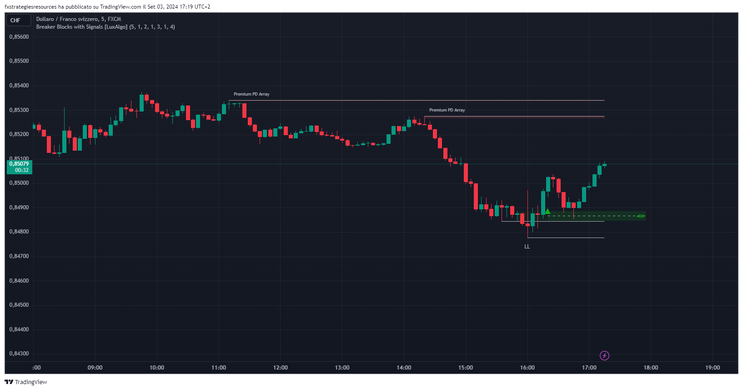13# Breaker Blocks with Signals
Submit by Maximo Trader
Breaker Blocks with Signals is a feature of the Lux Algo toolkit, which is a popular trading indicator suite designed for technical analysis, particularly in the forex, crypto, and stock markets. Here's a breakdown of what the "Breaker Blocks with Signals" indicator typically refers to:
Breaker Blocks with Signals
Breaker Blocks in Lux Algo are essentially dynamic support and resistance zones, derived from price action. They are similar to the concept of "order blocks" in trading, where institutional buying or selling has occurred, creating significant price levels. These blocks act as key zones where price reversals or strong continuations may happen.
Key Features:
-
Breaker Blocks: These are highlighted zones on the chart where there has been a significant price action shift. They typically act as potential reversal points or areas of interest where traders might expect price to either bounce off or break through.
-
Signals: Along with the breaker blocks, Lux Algo provides buy or sell signals based on price interaction with these blocks. When price approaches or enters a breaker block, the algorithm assesses whether there is a buying or selling opportunity based on the overall market conditions and momentum.
-
Confluence with Other Indicators: Lux Algo often uses multiple indicators to confirm signals. The Parabolic SAR, for instance, might be used alongside breaker blocks to strengthen a signal, as in the strategy you described.
Time Frame 5 min or higher
Currency pairs: any.
Application
Traders use Breaker Blocks with Signals to:
-
Identify potential reversal or breakout points.
-
Set up trades with clearer entry and exit strategies.
-
Use these zones as areas for placing stop losses or profit targets.
This tool is particularly useful in volatile markets where prices tend to move quickly and decisively, offering traders a framework to navigate these conditions with more confidence.
Example Usage
-
Buy Signal: If the price enters a breaker block (support zone) and the Lux Algo issues a buy signal (often shown as an arrow), traders might consider going long, especially if other indicators like the Parabolic SAR confirm the bullish sentiment.

-
Sell Signal: Conversely, if the price enters a breaker block (resistance zone) and the Lux Algo issues a sell signal, traders might consider shorting the asset.
How to find indicator in TradinView
1. Access TradingView
-
Go to the TradingView website and log in to your account. If you don't have an account, you can sign up for free.
2. Open a Chart
-
Once logged in, navigate to the "Chart" section by clicking on "Chart" in the main menu.
3. Open the Indicators Panel
-
At the top of the chart, you'll see a toolbar. Click on the icon that looks like a line graph with a small magnifying glass, which represents "Indicators."
4. Search for the Indicator
-
A pop-up window will appear where you can search for the indicator you want. Type the name of the indicator in English in the search bar. For example, if you're looking for the "Parabolic SAR," type "Parabolic SAR" in the search bar.
5. Add the Indicator to the Chart
-
Once you find the indicator in the search results, click on its name to add it to your chart.
6. Customize the Indicator (Optional)
-
After adding the indicator, you can customize it by clicking on the gear icon next to the indicator’s name in the chart's control panel.
Notes
-
If you're using TradingView in another language, some indicators may not appear under their translated names. It's always a good idea to search using the English name.
-
Advanced or custom indicators may require a premium subscription or could be created by community users, which you can find under "Community Scripts."
By following these steps, you can easily find and add any indicator on TradingView.
15 min Forex Strategies
122# 15 min MTF - Forex Strategies - Forex Resources - Forex ...
104# Vlad System 15 min Day Trading - Forex Strategies - Forex
154# 15 min Strategy - Forex Strategies - Forex Resources -
21# 15 min GBP/USD Range Breakout - Forex Strategies - Forex
130# 15 min Intraday Strategy - Forex Strategies - Forex
225# 15min Scalping - Forex Strategies - Forex Resources - Forex
301# Easy 15min Trading System - Forex Strategies - Forex ...
13# The Trend Setter, Channel Drawing Filter (15min) - Forex ...
228# Range Factor Scalping 15min - Forex Strategies - Forex ...
27# Lindencourt Method 15 TF - Forex Strategies - Forex







fahim (Saturday, 12 April 2025 04:41)
13# Breaker Blocks with Signals above indicatore send tradingview code or mt4 indicatore send my mailid `risan213@gmail.com